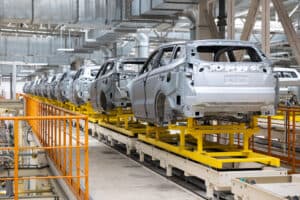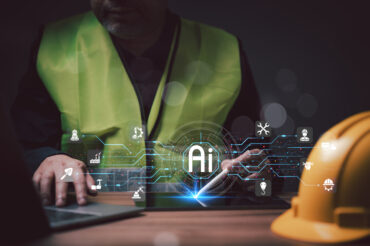
A discussion about the factors driving the need for smart manufacturing, key technologies that help auto manufacturers make that change, and the benefits they will realize in using the technologies and solutions.
The auto industry is undergoing multiple fundamental changes that are forcing auto manufacturers to rethink their operations. Most find they need to modernize and use smart technologies like digital twins, artificial intelligence, and machine learning to meet rapidly changing customer demands, address supply chain issues, meet sustainability goals, and more.
RTInsights recently sat down with Nand Kochhar, Vice President of Automotive and Transportation Industry Strategy with Siemens Digital Industry Software, and Greg Roth, Solution Director in the Automotive Industries at Siemens to talk about the factors driving the need for smart manufacturing, key technologies that help auto manufacturers make that change, and the benefits they will realize in using the technologies and solutions.
Here is a summary of our conversation.
RTInsights: What’s going on in the automotive manufacturing market that requires a change to intelligent manufacturing?
Kochhar: The automotive industry is going through a major transformation for many reasons, including changing consumer demands and new connected products. There is also the change to electrified products, what we call vehicle electrification. That includes fully battery-powered electric vehicles, plugin hybrids, and other powertrain combinations. One of the other key trends we see is the need for automated driver assist systems and consumers’ aspiration to get to fully autonomous vehicles someday.
Those are some of the major changes from a consumer trend standpoint, which are driving the change for the automotive OEMs and their entire ecosystems.
Some of the need for change is coming from government regulations, emissions standards, and the overall push for sustainability. These additional factors are driving changes, which are huge for automotive OEMs, who’ve been producing internal combustion engine-based vehicles for over a hundred years.
In addition to changing consumer demand and regulations pressure, technology is changing. Everyone is looking for smart-connected products, and the car has become one of those smart-connected products.
So, intelligent manufacturing is needed because innovations are happening at a very high speed. Everyone is looking for new features and functions.
RTInsights: What are the key technologies that can help a manufacturer move to more intelligent operations?
Kochhar: One of the key technologies, at the highest level, is digital transformation, also referred to as digitalization. Connected to that would be many different elements of digital transformation that bring together and integrate IT and operational technologies. Additionally, there are artificial intelligence and machine learning. Those technologies are some of the most important things that can help manufacturers move to intelligent operations.
From a Siemens standpoint, there are many examples of how that is prevalent and how we help our customers accomplish their goals.
For example, in solving a problem, the first thing is visualization of the issues. Most manufacturing companies have global operations, and it is important that every plant is able to report and resolve issues. A lot of the change control during manufacturing goes unreported. Yet, the design release engineers need that information to make changes.
So, we worked with our ecosystem of partners to bring together Teamcenter and Microsoft Teams, where you could build in AI and voice recognition technologies. A worker anywhere in a plant around the globe can speak in any language and report an issue. Leveraging AI technologies, those spoken reports and issues can feed directly into Teams and then from Teams into Teamcenter. Then, the designer release engineers can focus on solving and collaborating with manufacturing at a global scale and level.
That’s just one very basic example of how AI and machine learning technologies are making operations more intelligent.
RTInsights: How does Siemens help in this area?
Kochhar: There are three key elements of Siemens smart manufacturing solutions that help our customers make their operations more intelligent.
Let’s start with the virtual development of manufacturing.
The ability to virtually design, simulate, test, and commission your line is a critical step to achieving smart manufacturing. It starts with a concept at the design level. A detailed design of every aspect of the line is created, built, and tested. The process is iterated until a final design is completed. All of this is done before it gets into the phase of actually building the line.
It is very important that the virtual development process is accurate and addresses all the issues before you make the handoff to manufacturing for the launch of your line. To establish a flawless launch, it is important that you have what we call a digital thread, which connects all aspects of product design and development going into manufacturing.
Once you’re into the manufacturing stage, the implementation of intelligent technologies can help you to rapidly revolutionize your factory.
In a traditional manufacturing environment, you have to leverage the existing capital equipment, processes, and resources. Not everyone has an opportunity to have a clean sheet or a green field. Most companies have their existing factories and operations, so you have to find ways to refresh or modernize the equipment, processes, and resources and then apply those changes to accomplish the goal of delivering a flawless launch. That’s a very important part of the rapid factory revolution.
A third area where we help is in intelligent production excellence. Once the modernization is achieved, that sets the stage for what we call closed-loop communications functionality. That functionality can be integrated with AI and live twin capabilities and go on to the extremes of factories addressing issues in real time. So, that is true smart manufacturing. In other words, once you have the data and the IT/OT integration, then you have all these abilities to do predictive maintenance and more.
At that stage, based on insights, continuous learning and updating are taking place, not only of the processes but also of the people. That means that every product coming out is better than the one that just came off the line before, whether it’s a component or a full vehicle. That is an important part of building intelligence into production.
RTInsights: What benefits do manufacturers realize from these solutions and technologies today?
Kochhar: The most important one is, depending on where the manufacturer is in its journey on this digital transformation, they receive actionable insights before doing any physical commissioning that can accelerate modernization.
So, if you’re building a new plant, you can do all these things virtually. Others who have been on this journey and are continuously updating can apply AI and machine learning in the ways I just touched on. They can also go all the way into self-correcting plants and have flexible manufacturing. In other words, you can predict operational issues before they happen because now you have all these data-connecting technologies. You’re taking this information and doing analytics on it, whether on-premises or on the cloud, and feeding that back into manufacturing. And in some cases, you’re feeding those insights all the way back into the product design so you can update the designs for the next stage of the product.
Another benefit comes when you have to increase the line speed. As you know, the demand for the products ebbs and flows, and balancing that with the labor you have in the plants, you can adjust the line speeds to get from a slow speed build to a full line speed. Digital technologies bring a lot of benefits to our customers and their customers in this area.
RTInsights: Looking to the future, what’s on the horizon? What other things will manufacturers be able to do with these technologies?
Kochhar: In addition to traditional product development and manufacturing, one very important thing for most businesses is to truly deliver sustainability, not only just meet sustainability goals.
In a manufacturing environment, whether it’s reduction of water usage or CO2 footprint calculations, carbon calculations, etc., our technologies can be used to deliver that sustainability by design, not just doing sustainability at the end of the production processes.
Another area is robust logistics. As you know, the supply chain issues were not only just happening during the pandemic. There are other disruptions in all parts of the world for one reason or another, whether it’s a war or a supply chain problem, because of the availability of shipping. A lot of those logistics issues can be visualized by integrating the technologies from our design, let’s say, bill of material solutions, to manufacturing to tracking the supply chain through Siemens Digital Logistics. That’s how we get a resilient supply chain so that at the end of the day, production at the plants and the factories doesn’t get challenged.
Adapting to consumer demands is another area where these technologies can play a role. I talked about the trends around electrification, ADAS, and more. All of these things are evolving. We’ve already noticed a company starting with full-battery electric vehicles and switching back to plugin hybrids. That’s based on the supply chain issues and the raw materials to process materials for making batteries.
Using intelligent manufacturing technologies, you have the ability, since you have all of this digital information, to adjust to those consumer demands and address not only products but also the manufacturing of those products. The flexibility of doing multiple product types on the same line becomes very important. With intelligent manufacturing, companies can be prepared to deliver and adapt to consumer demands.
And again, intelligent manufacturing lets you embrace globalization. As you know, there are several elements of it. Glocalization or globalization, companies are kind of back and forth from onshoring to offshoring and producing things in a certain part of the world. Intelligent manufacturing allows you to address all those issues once you have the digital transformation going through your company.
RTInsights: Is there anything else we should consider in this topic area?
Roth: The one thing I would add is that smart manufacturing provides the resilience for manufacturing sites to recover from disruptions. That’s another kind of main benefit. It could forecast line shutdowns and supply chain problems ahead of time so that companies can react in a timely manner and then recover from those disruptions much, much faster.
Additional Resources

Drive production excellence with intelligent manufacturing
The automotive industry is facing unprecedented challenges, with rapid change and intense pressure to meet the demands of climate change, regulations, and consumers. Download Now

Modernize automotive factories with Siemens Smart Manufacturing solutions
Discover how automakers can transform their business with Smart Manufacturing solutions using state-of-the-art hardware and software to modernize production lines. Watch Now

Virtual Manufacturing Development for the Automotive Industry
Companies in the automotive industry are pushing to develop the next generation of autonomous, electric, connected, and shared vehicles. View Now







